About 40-80% of people complain that the spine hurts in the lumbar region, but up to 25% ask for medical help. In fact, such discomfort can be caused by both relatively harmless causes and pathological changes in the spine. Therefore, they should not be mocked.
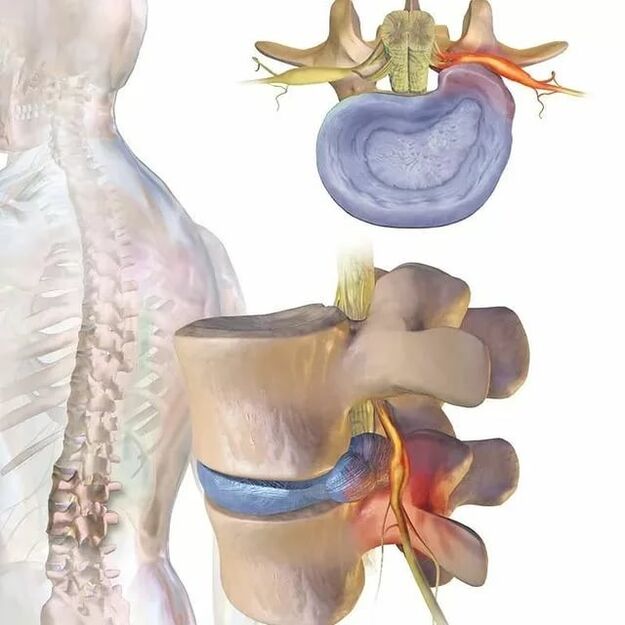
Causes of back pain
The spine consists of a whole complex of structural elements: bones, joints, intervertebral discs, ligaments, nerves. Any of these changes can be accompanied by painful feelings and are of a different nature. In addition, the spinal column is surrounded by paravertebral muscles, a pain in which patients often confuse it with spinal pain. Thus, the causes of pain can be many and varied. This can be overload, natural rearrangement of the body during pregnancy, and so on. But if pain occurs regularly, you may want to see a vertebrologist or neurologist, as often the fact that the spine systematically hurts in the lumbar region indicates the development of certain diseases. .
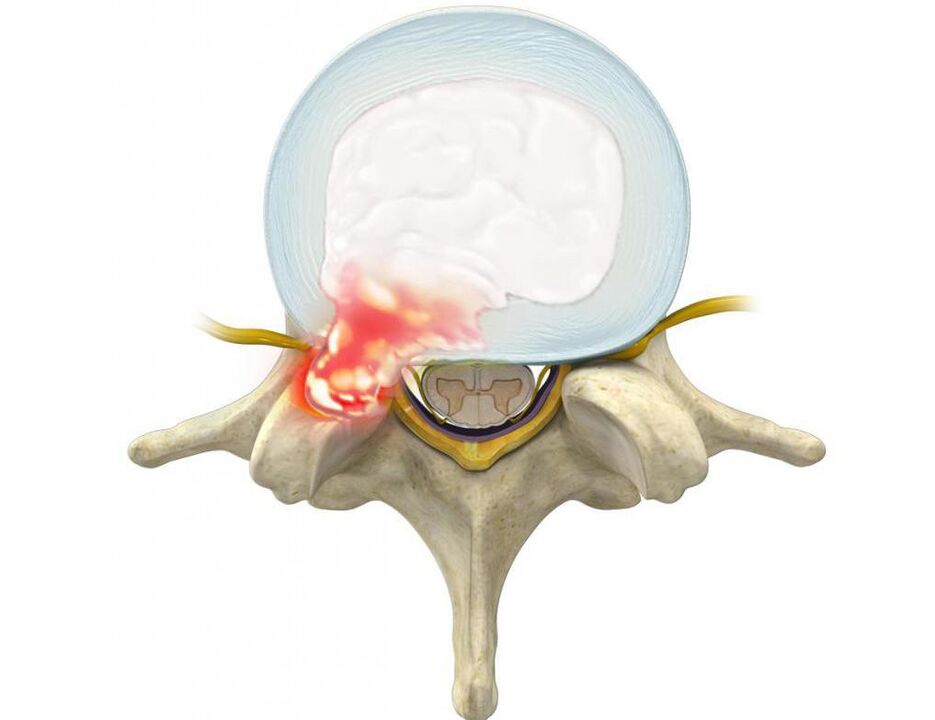
Most often, in such situations, patients are diagnosed with:
- pathology of intervertebral discs (decreased plate height, protrusion, intervertebral hernia, discitis);
- faceted joint pathologies (spondyloarthrosis, joint cysts);
- inflammatory diseases (ankylosing spondylitis or ankylosing spondylitis, reactive arthritis, psoriatic arthritis)
- compression fractures of the vertebrae in the background of osteoporosis;
- neoplastic lesions of the spine.
Pathologies of the intervertebral disc
Degenerative lesions of the intervertebral discs or osteochondrosis are very common, especially in the young and middle-aged. This is largely due to the fact that you have to sit for long periods of time or do heavy physical work. In old age, the disc dries out and the vertebrae converge.
Already in the initial stages of degenerative lesions of the intervertebral discs, which are cartilages with special configurations that divide the vertebral bodies, pain can occur in the spine. This is due to irritation of the pain receptors in the outer layers of the disc as well as the posterior longitudinal ligament of the spine. Osteochondrosis often triggers an aseptic inflammatory process that leads to reflex spasm of the segmental muscles. As a result, spinal pain is exacerbated and there are restrictions on movement.
Osteochondrosis continues to develop, especially in the absence of appropriate treatment and lifestyle correction. It then leads to protrusions and later to intervertebral injuries, which causes the existing symptoms to worsen and new ones to appear.
The lumbar region is most often affected, as it carries the greatest load during daily activities.
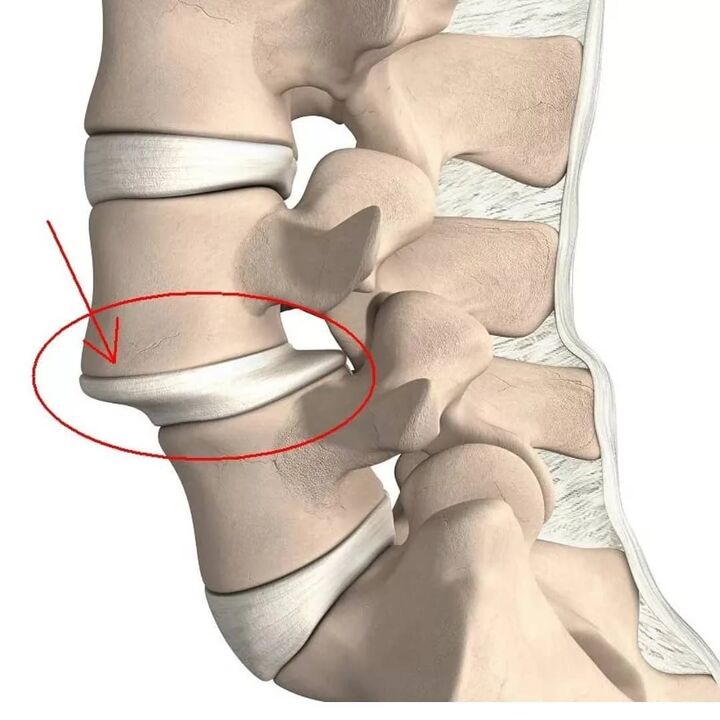
The protrusions are the protrusions of the plate while preserving the integrity of the outer shell, called the annulus fibrosus. The fibers of the annulus fibrosus, while maintaining the effect of the provocative factors over time, cannot withstand the load and pressure of the inner contents of the disc (nucleus pulposus) as well as the rupture. As a result, the nucleus goes beyond the physiological position of the intervertebral disc. However, the lumbar spine always hurts or the pain radiates to the leg, with sudden movements, bending, lifting heavy objects, straining, coughing, sneezing, laughing, and feeling uncomfortable in prolonged sitting. a position, walking, job.
Patients with pre-existing protrusions and hernias often unconsciously take on a forced position, leaning slightly toward the healthy side. In this case, the pain in the spine in the lumbar region can be of high intensity, depriving the person of the ability to work. In this case, he is forced to adhere to bed rest, and to relieve the pain, he stretches his bent and abdominal legs.
Most often, protrusions and hernias develop in the direction of the spinal canal, through which the spinal cord (cauda equina) and the nerve roots branching from it pass. The latter pass through the natural openings in the vertebral bodies and continue to branch into the lumbar plexus, which is responsible for the innervation of the lower extremities and various organs (including the genitals).

Therefore, often in the case of long-term osteochondrosis, the hernia in the lumbar region, the pain in the spine, not only increases, but is complemented by other disorders. If a deformed disc or swollen soft tissue due to an inflammatory process compresses the spinal cord passing near them, neurological disorders will occur. Therefore, spinal pain in the lumbar region can be supplemented by radiation to the buttocks, groin, anterior, inner, outer thighs, legs, and feet. It depends on which nerve root will be damaged, i. e. at which level of the spinal motion segment abnormalities can be observed. In addition, sensitivity disturbances in the appropriate zones of the lower extremities are observed in the form of creep, numbness, temperature sensitivity, pain, tactile stimuli, and limited mobility.
Changes in the height and function of the discs in osteochondrosis and its complications lead to damage to the spinal joint apparatus and degeneration of the vertebral bodies themselves. This results in spondylosis, which is the calcification of the anterior longitudinal ligament and the formation of bone cartilage growths (osteophytes) on the surface of the vertebral bodies. Not only can they damage the surrounding tissues and compress the roots of the spine, causing severe pain in the spine, but they can also grow together. As a result, the adjacent vertebral bodies merge into a single whole, sharply limiting mobility in the lower back.
Osteochondrosis can be accompanied by reactive changes in the vertebral bodies, especially reactive aseptic spondylitis, leading to osteosclerosis. This is accompanied by compaction of bone tissue and dramatically increases the likelihood of vertebral fractures.
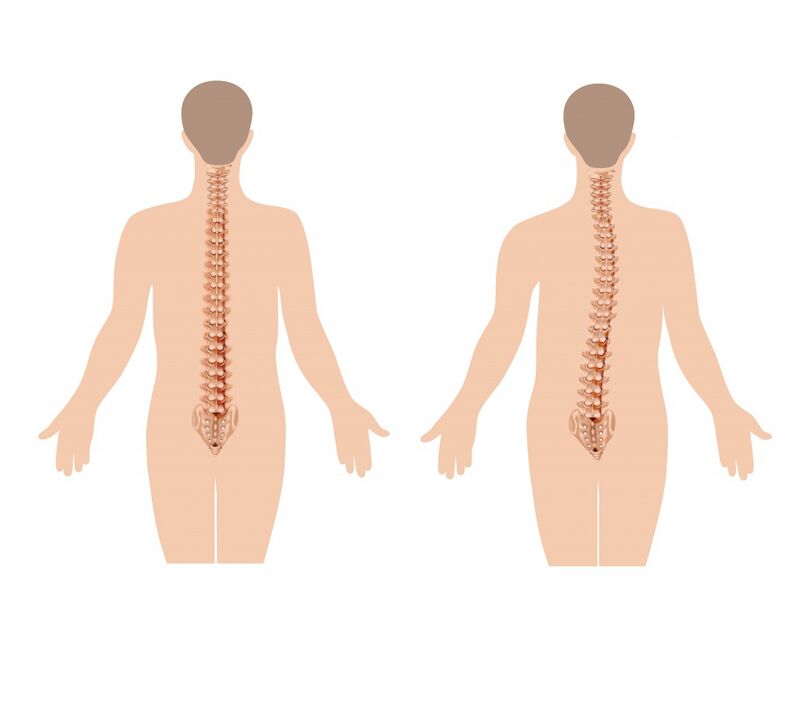
Facet joint diseases
Pathologies of the facial spine or faceted joints, especially their arthrosis, can also cause pain in the spine in the lumbar region, including severe pain. Although more often the pain hurts and is deep inside. Their appearance is due to the fact that their joint capsule is richly innervated. In such situations, the pain is usually concentrated directly in the affected area and is exacerbated by bending, stretching, turning the body during prolonged standing. Walking and sitting reduce their severity. But in some cases, the lumbar region, the coccyx, and the outside of the back and thighs can also cause pain.
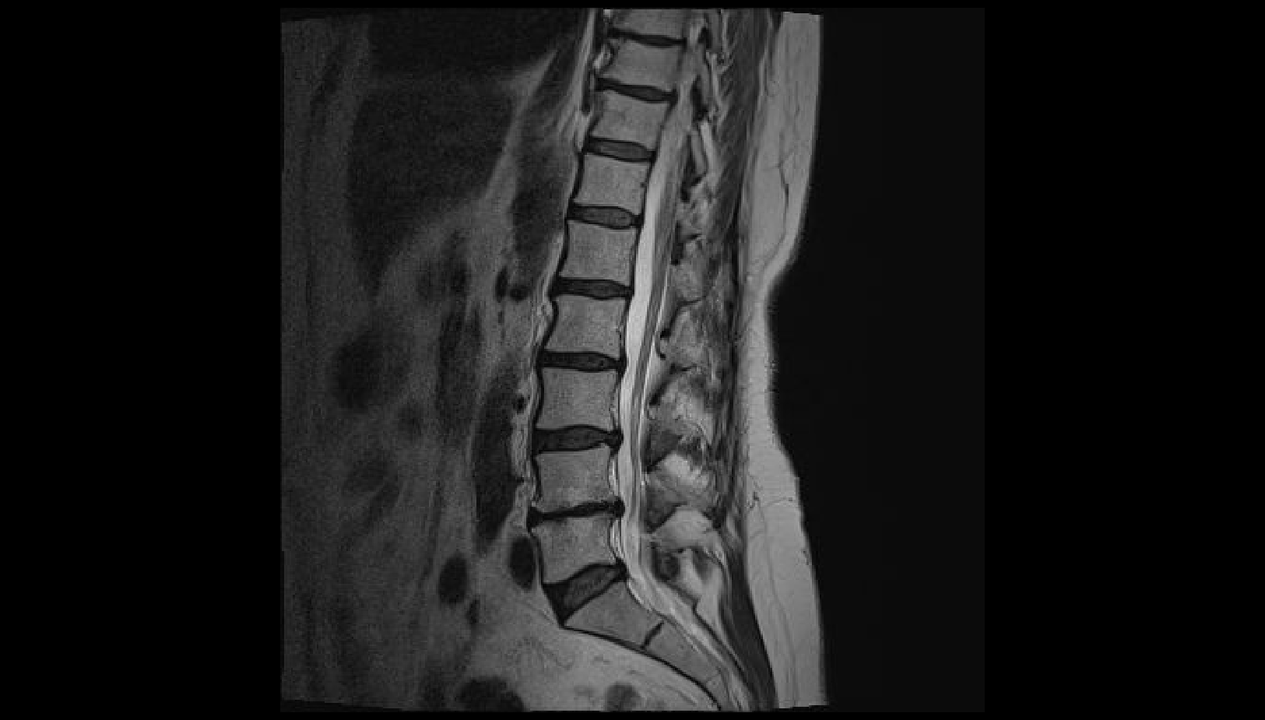
Inflammatory diseases of the spine
Inflammatory diseases of the spine are less common than pathologies of the intervertebral discs and beveled joints. However, the spine is also hurt. These include:
- ankylosing spondylitis or ankylosing spondylitis;
- reactive arthritis;
- psoriatic arthritis, etc.

Symptoms of these diseases usually appear before the age of 40, more often before the age of 20. This distinguishes them from degenerative-dystrophic pathologies of the plates and joints of the spine, which often develop after 40 years. In this case, the pain is characterized by a gradual increase in intensity. Moreover, their severity decreases after physical exertion, but does not decrease at rest. Therefore, in inflammatory diseases of the lumbar region, the spine often hurts at night and especially severely in the morning, immediately after sleep.
The most difficult situation is observed in ankylosing spondylitis, and he is the one who affects the lumbar region more often than other inflammatory diseases. This term refers to inflammation of the intervertebral joints followed by immobilization, which results from the formation of dense bone, cartilage, or fibrous fusion between the articulating bone structures.
It is characterized by mild back pain at first, but gradually spreads up over time, covering the chest and then the cervical spine. This is related to the development of any planar mobility restrictions in the spine, as the spinal column appears to be submerged in a specific case due to the changes that take place. They also observed:
- alignment of lumbar lordosis (natural curvature of the spine in the lumbar region);
- exacerbation of thoracic kyphosis causing curvature;
- reflex tension in the back muscles;
- the gradual aggravation of the restriction of mobility due to the involvement of the faceted joint in the pathological process and the ossification of the intervertebral discs;
- morning stiffness for an hour or more.
Inflammation of the iris (iritis), cornea (keratitis), mucosa (conjunctivitis), iris and ciliary body (iridocyclitis) is observed in 10-50% of patients.
The progression of ankylosing spondylitis leads to the fact that more and more joints in the pathological process. As a result, patients are forced to master the so-called prayer pose. This means pronounced kyphosis of the thoracic spine, downward tilt of the upper body, bending of the knee with a sharp restriction of the range of motion of the chest, which affects the depth of breathing.
The rate of disease progression depends on the adequacy and completeness of treatment.
Compression fracture of the vertebrae
Compression fracture is a flattening of the vertebral body that results in a wedge shape. This leads to disruption of the anatomy of the spine, can cause trauma to the spinal cord and its roots, and becomes a trigger for the rapid progression of degenerative-dystrophic lesions.
Lumbar vertebrae 1 and 2 are more susceptible to injury because they absorb the greatest axial load.
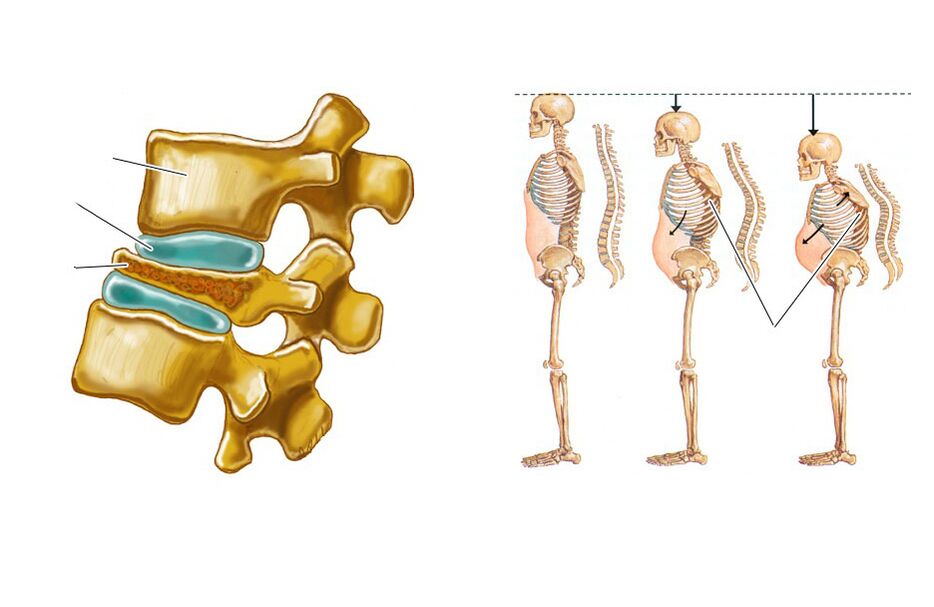
Compressive fracture of the spine often occurs in the elderly due to the development of osteoporosis, i. e. , a decrease in bone density. In this case, not only a slight fall, but also a weightlifting, unsuccessful move may be enough to injure you.
The pathology is characterized by the presence of spinal pain that restricts movement, is exacerbated by sitting, movement, and lifting the straight leg. It usually lasts for 1-2 weeks and then gradually decreases over 2-3 months. In some cases, pain is radiated to the hip bones and the spine of the hip bones. A decrease in the height of a broken vertebrae provokes an increase in lumbar lordosis, which also contributes to the occurrence of painful feelings.
If the fracture is not diagnosed in time, a decrease in the height of the vertebrae will lead to a change in posture, a decrease in growth. This causes reflex tension and shortening of the spinal muscles, which causes chronic back pain and requires long rest.
Neoplastic lesions of the spine
Neoplastic lesions of the spine include the development of benign and malignant tumors, as well as metastases from other organs. This is much less common than in pathologies of intervertebral discs, facial joints, ankylosing spondylitis, and even compression fractures, in 1-2% of patients with back pain. However, such lesions require the earliest possible diagnosis and treatment.
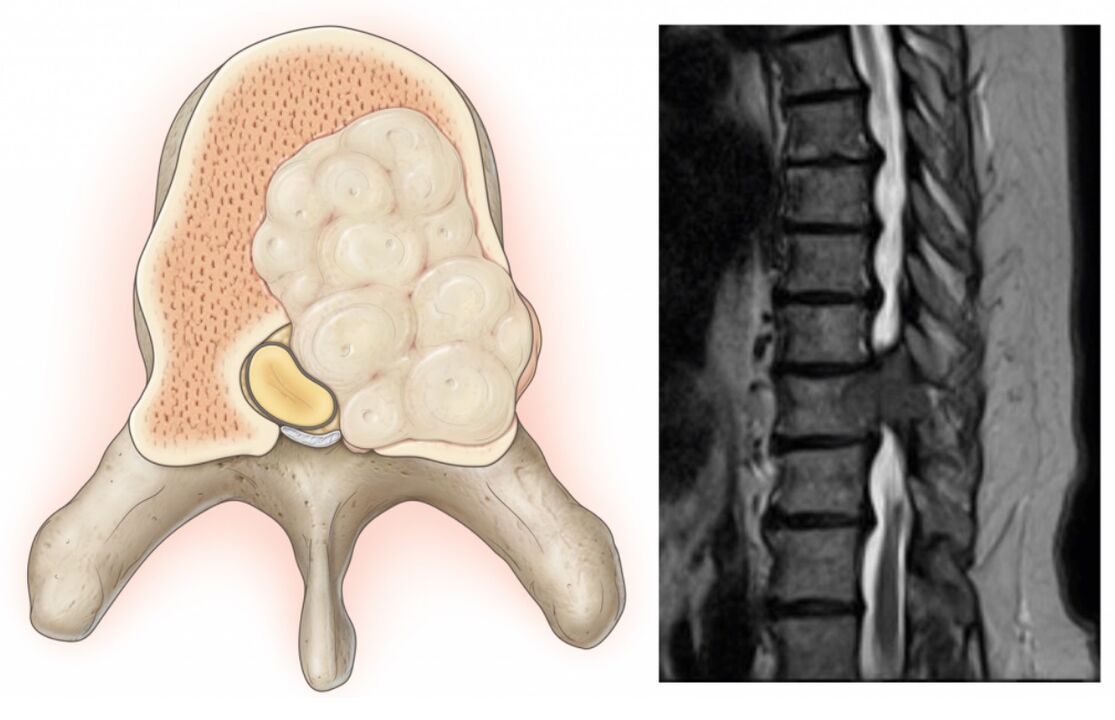
The characteristics of neoplastic lesions of the spine in addition to pain are as follows:
- increase in body temperature, including subfebrile values;
- unjustified weight loss;
- inability to find a comfortable posture;
- presence of pain at night;
- severe pain in the spine;
- inability to relieve pain with conventional painkillers.
Even if 1 or 2 of the above symptoms occur, ask your doctor for an appointment immediately.
Similarly, the following may appear:
- Chondroma is a malignancy that is diagnosed in 20% of patients with spinal cancer. It is most commonly formed in the sacrum and can occur in people of any age and gender.
- Young sarcoma - occurs in 8% of patients with cancer of the spine. More common in young men.
- Chondrosarcoma is a malignancy that accounts for 7-12% of cases. It is more common in middle-aged men.
- An aneurysm bone cyst is a benign tumor.
- Hemangioma is a benign vascular tumor that occurs in 11% of people. It may not be noticeable to a person during their lifetime. But it increases the risk of vertebral fractures.
- Metastases of other tumors are secondary malignancies. Breast, prostate, and lung cancers are more common, and kidney, thyroid, and skin cancers are metastatic to the spine.
Diagnostics
If your spine hurts in the lumbar region, you may want to make an appointment with a neurologist or vertebrologist. At the prescription, the doctor initially collects a medical history, asks questions about the nature of the pain, the circumstances of its occurrence, its duration, the presence of other symptoms, lifestyle, and so on.
The specialist will then perform an examination. In the framework of this, it not only assesses the palpation of the spine, the determination of the localization of pain, the unconscious gait and posture of the patient, but also performs functional examinations. They can be used to detect signs of ankylosing spondylitis, neurological deficits, assess spinal motility, and provide other diagnostic data.
Based on this, the doctor may already assume the possible causes of the pain syndrome. Instrumental and sometimes laboratory diagnostic methods are also required to clarify these and to accurately determine the extent of damage. The most common help is:
- radiography in frontal and lateral projection, sometimes with functional radiological examinations;
- CT - allows better visualization of bone structures, so it is more commonly used for spondylosis, fractures, bone tumors, etc. to diagnose;
- MRI - allows the condition of cartilage structures and soft tissues to be assessed as accurately as possible and is therefore often used for osteochondrosis, protrusions, intervertebral hernia, spinal cord lesions, etc. to diagnose;
- electromyography - for neurological disorders of unknown origin and for assessing the extent of nerve damage;
- radioisotope bone scintigraphy - for the diagnosis of malignancies and metastases;
- X-ray densitometry is the best method for diagnosing osteoporosis;
- myelography - to show signs of nerve compression in the spinal cord and cauda equina.
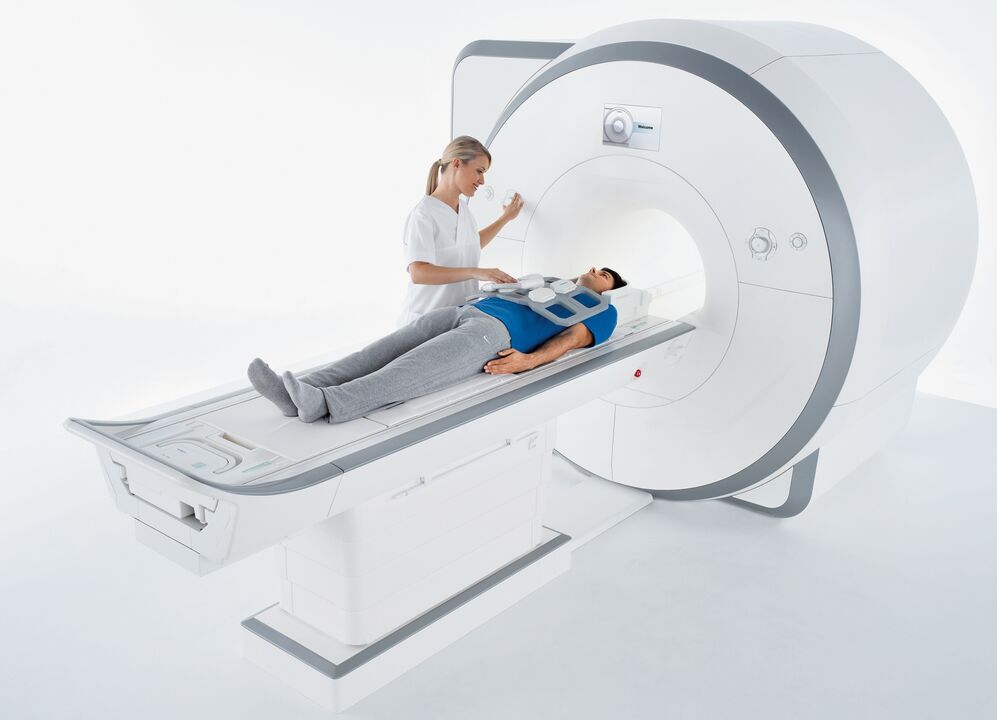
Treatment
For each patient, treatment is selected on a strictly individual basis and not only on the basis of the diagnosis but also the nature of the existing concomitant pathologies. Nevertheless, the cause of the back pain determines the therapy tactics. This may involve conservative or surgical intervention.
But the first step is always to manage pain relief efforts, especially if it is strong. To do this, patients prescribe NSAIDs, antispasmodics, and painkillers. In severe cases, spinal obstructions are performed - injections of anesthetics and corticosteroids at certain points in the spine.
Bed rest is not visible to all patients. And in the case of pathologies of the intervertebral discs, this may be completely contraindicated, as the decrease in physical activity contributes to the transformation of acute spinal pain into chronic.
Only conservative or non-surgical treatment is prescribed:
- osteochondrosis;
- ankylosing spondylitis;
- arthrosis of faceted joints;
- light compression fractures.
It is usually complex and consists of:
- drug therapy, which may include NSAIDs, chondroprotectors, muscle relaxants, immunosuppressants, corticosteroids,
- physiotherapy (UHF, magnetotherapy, laser therapy, traction therapy, etc. );
- Practice therapy;
- manual therapy.

If the cause of the back pain is an intervertebral hernia, protrusion, spondylosis, severe vertebral fracture, tumor, often surgical intervention is required. You also need:
- ineffectiveness of conservative therapy for degenerative-dystrophic changes;
- increase in neurological deficits;
- instability of the spinal motion segment;
- development of complications, especially narrowing of the spinal canal.
Most modern spinal surgeries are minimally invasive. As a result, intraoperative and postoperative risks are significantly reduced, the rehabilitation period is shortened and made easier, and the effectiveness is no lower than in more traumatic open surgeries. Depending on the disease diagnosed, it is recommended that:
- Discectomy is recommended primarily for hernias and protrusions, especially in cases of cauda equina syndrome. It can be performed with microsurgical devices, a 3 cm incision (microdiscectomy), and an endoscopic device inserted into the spine with punctures about 1 cm in diameter (endoscopic discectomy). When the intervertebral disc is completely removed, it is usually replaced with implants.
- Vertebral surgery and kyphoplasty - recommended for compression fractures of vertebrae, hemangiomas and some other diseases. The essence of the surgery is to inject rapidly curing bone cement into the vertebral body through a thin cannula, which strengthens it. In addition, kyphoplasty makes it possible to restore the vertebral body to its normal size, which is important in the event of a significant drop in height due to a fracture.
- Fixative surgeries are used to stabilize the spine. Other types of metal structures are used for this, which usually remain in the patient's body for the rest of his life.
Thus, the spine of the lumbar region can hurt for a variety of reasons. Therefore, it is essential to contact a vertebrologist or neurologist if pain persists, persists, increases over time, and even more so. Early diagnosis allows pathological lesions to be recognized at the stages when they are easiest to deal with, and if the disease does not completely heal, at least stop its progression and maintain a high standard of living.













































